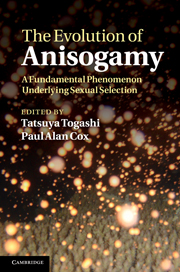Book contents
- Frontmatter
- Contents
- Contributors
- Introduction: The evolutionary mystery of gamete dimorphism
- 1 The origin and maintenance of two sexes (anisogamy), and their gamete sizes by gamete competition
- 2 The evolutionary instability of isogamy
- 3 Contact, not conflict, causes the evolution of anisogamy
- 4 Nucleo-cytoplasmic conflict and the evolution of gamete dimorphism
- 5 Adaptive significance of egg size variation of aquatic organisms in relation to mesoscale features of aquatic environments
- 6 Gamete encounters
- 7 Evolution of anisogamy and related phenomena in marine green algae
- Index
- References
6 - Gamete encounters
Published online by Cambridge University Press: 19 May 2011
- Frontmatter
- Contents
- Contributors
- Introduction: The evolutionary mystery of gamete dimorphism
- 1 The origin and maintenance of two sexes (anisogamy), and their gamete sizes by gamete competition
- 2 The evolutionary instability of isogamy
- 3 Contact, not conflict, causes the evolution of anisogamy
- 4 Nucleo-cytoplasmic conflict and the evolution of gamete dimorphism
- 5 Adaptive significance of egg size variation of aquatic organisms in relation to mesoscale features of aquatic environments
- 6 Gamete encounters
- 7 Evolution of anisogamy and related phenomena in marine green algae
- Index
- References
Summary
INTRODUCTION
A gamete must encounter a partner gamete before it can contribute to the formation of a new individual with a new array of genetic information. Thus, it is natural to consider whether the advantage of anisogamy might be that it aids gamete encounters. Since it is plausible that both a larger number of smaller gametes can be formed and a larger gamete presents a larger target for another gamete, it is plausible to suppose that the combination of a few large and many small gametes might lead to more encounters than an equal investment in gametes all of the same size. Thus, anisogamy might have evolved from isogamy under selection for higher rates of encounter between gametes of two mating types.
In order for the encounter process to be a strong evolutionary force, encounters must be relatively rare. In situations where each gamete is likely to encounter many partners, there may be selective pressures for gametes to play hard-to-get and select for fertilization by only the most competent of partners (correlating with better genes). On the other hand, if the probability of encountering any suitable gamete is low, there will be selective pressure to produce gametes that have the greatest chance of encountering any suitable partner. In oogametic species, these two situations are frequently called sperm competition and sperm limitation. Thus, a critical question becomes whether a given gamete is likely to encounter many or no fitting partners.
- Type
- Chapter
- Information
- The Evolution of AnisogamyA Fundamental Phenomenon Underlying Sexual Selection, pp. 168 - 193Publisher: Cambridge University PressPrint publication year: 2011
References
- 4
- Cited by



